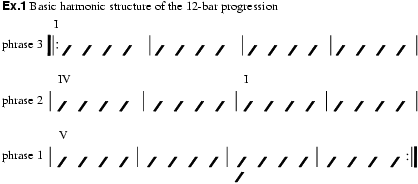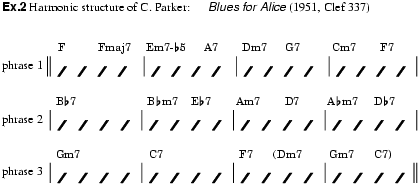
The underlying harmonic structure of the blues. In the broad sense, the term can refer to the harmonic basis of any piece called a Blues (an exhaustive survey of these progressions can be found in Dauer), but it must be noted that in an attempt to capitalize on the blues craze of the early 1920s, popular songwriters used ‘blues’ in the titles of pieces whose harmonies bear no relation to that of the blues progression (e.g. Limehouse Blues). In the narrow sense, it refers to a flexible, cyclic 12-bar structure, consisting of three four-bar phrases with the chord pattern shown in ex.1. Many variants of this pattern are possible: frequently IV is used in place of I in bar 2, or in place of V in bar 10. Country blues guitarists characteristically vary the rhythms of the basic progression, and sometimes maintain a tonic drone on the bass strings; in this case a blues harmonic progression may be intimated by the vocal and treble-string melodies.

Themes based on 12-bar blues progressions appeared in ragtime compositions from 1904; later, composer–collectors of the blues published multi-thematic ‘blues’, combining 12-bar blues progressions with 16-bar ragtime themes and popular songs (e.g. W.C. Handy's Memphis Blues, 1912). These hybrid pieces were popularized by ‘classic’ blues singers such as Mamie Smith and Bessie Smith from 1920. A few years later, in 1923, recordings by innovative black jazz ensembles from New Orleans revealed that there were several established variants from the standard blues pattern. Only later were field recordings made of rural blues musicians. Because of this confusion in the sources it is impossible to establish an original form of the blues progression.
Jazz, particularly bop, musicians took advantage of the flexibility inherent in the simple 12-bar scheme and often presented it in new guises using a variety of passing and substitute harmonies. An extreme example is Charlie Parker's Blues for Alice (1951; ex.2) with its interpolated secondary dominant progressions. A minor-mode form of the blues progression also exists, which later became a common characteristic in soul jazz. Drummers, most notably Max Roach, have adapted the blues progression and poetic form to unaccompanied solos, translating the 12-bar blues into percussive terms; a fine example is found in Roach's solo in the middle of ‘Blue Seven’ on the Sonny Rollins album Saxophone Colossus (1956, Prst.)

Broadly speaking, the blues progression entered the repertory of rock musicians from two distinct sources: from rock and roll and from country and urban blues. It is found in its simplest form (ex.1) in Bill Haley's Rock Around the Clock (1954) and across the spectrum of rock and roll, including Jerry Lee Lewis's Whole Lotta Shakin' Goin' On (1957) and Chuck Berry's Johnny B. Goode (1958). Gene Vincent's Be-bop-a-lula and Little Richard's Tutti Frutti (both 1956) use IV in bar 10 – this is the most common variant – while Fats Domino's Ain't that a shame (1955) uses IV–IV–V–V in the last four bars. Thereafter, the 12-bar pattern and its variants entered the work of Buddy Holly (Peggy Sue and Oh Boy, both 1957), the Everly Brothers (Bird Dog, 1958), the Beach Boys (Little Deuce Coupe and Surfin' USA, both 1963) and, ultimately, the Beatles (A Hard Day's Night and Can't buy me love, both 1964) and the Rolling Stones (19th Nervous Breakdown, 1966). By this point, it had lost touch with the conventionalized AAB pattern of the blues lyric...\Frames/F922567.html
In the later 1960s, blues rock musicians returned to the blues pattern, but through the influence of country and blues musicians (such as Robert Johnson, Elmore James and Willie Dixon) rather than early rock and roll. In Fleetwood Mac's Dust my broom (1968), this resulted in a strict adherence to the pattern; in Cream's Sunshine of your Love (1967) the riff is transposed rather than remaining on the same pitch; while in Led Zeppelin's Since I've been Lovin' You (1970), the substitution-rich pattern is found in the bass alone (ex.3).
![]()
GroveJ
SchullerEJ
L. Koch: ‘Structural Aspects of King Oliver's 1923 Okeh Recordings’, JJS, iii/2 (1976), 36–46
E. Newberger: ‘Archetypes and Antecedents of Piano Blues and Boogie Woogie Style’, JJS, iv/1 (1976), 84–109
J. Titon: Early Downhome Blues: a Musical and Cultural Analysis (Urbana, IL, 1977)
A. Dauer: ‘Towards a Typology of the Vocal Blues Idiom’, Jazzforschung/Jazz Research, xi (1979), 9–92
P. van der Merwe: Origins of the Popular Style: the Antecedents of Twentieth-Century Popular Music (Oxford and New York, 1989)
B. Kernfeld: What to Listen for in Jazz (New Haven, CT, 1995)
BARRY KERNFELD, ALLAN F. MOORE